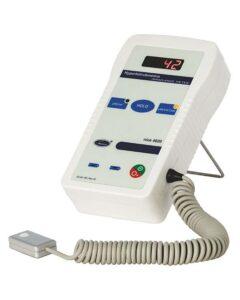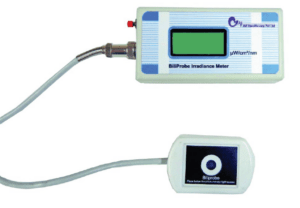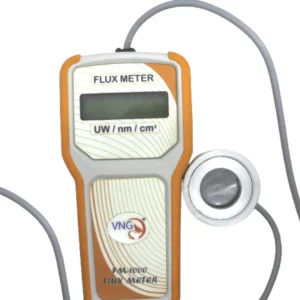Are you curious about the crucial role that medical irradiance meter play in the healthcare industry? In this blog, we will delve into the world of medical irradiance meters and explore their significance in ensuring accurate radiation dosage and optimizing treatment outcomes.
Medical irradiance meters are indispensable tools in the healthcare industry. They play a vital role in measuring light intensity and ensuring precise radiation dosage during various medical procedures. Understanding their features, applications, and differences is essential for healthcare professionals, researchers, and anyone involved in medical device procurement.
In the medical field, irradiance meters are employed for various purposes, including skin care, phototherapy, and laser treatments. They help healthcare professionals accurately measure and control the intensity of light used in these procedures, ensuring patient safety and treatment effectiveness.
What Is a Medical Irradiance Meter?
A medical irradiance meter is a specialized device designed to measure the intensity of light used in medical procedures. By providing accurate readings, these meters help ensure the appropriate dosage of radiation is delivered to patients. They are utilized in diverse medical fields, including dermatology, phototherapy, and other treatment modalities.
Understanding Irradiance Measurement
Understanding Irradiance Measurement in Medical Applications In the medical field, understanding irradiance measurement plays a crucial role in various applications and procedures. Irradiance meters are invaluable tools that aid in measuring the intensity of radiant energy, which is essential for ensuring patient safety, optimizing treatment outcomes, and evaluating the performance of medical devices.
A critical application of irradiance measurement in the medical field is the assessment and monitoring of UV radiation levels. Medical instruments, including UV therapy lights and sterilization equipment, emit UV radiation, measured by UV irradiance meters. By accurately measuring UV irradiance, healthcare professionals can ensure that patients receive the appropriate dosage of UV therapy for conditions like psoriasis or monitor UV exposure during sterilization processes to ensure the effectiveness of the disinfection procedures.
Additionally, irradiance meters are utilized in evaluating the performance of light-based medical devices, such as lasers and phototherapy systems. By measuring the irradiance levels emitted by these devices, healthcare providers can verify that the devices are operating within the desired parameters for optimal treatment efficacy and patient safety.
Overall, understanding irradiance measurement is essential in the medical field to ensure the precise and accurate delivery of various treatments and therapies. By utilizing irradiance meters, healthcare professionals can confidently assess UV radiation levels, optimize treatment outcomes, and ensure light-based medical devices safe and effective use.
Types of irradiance meters
There are several types of irradiance meters available, each designed to measure specific types of light intensity. Here are some common types of irradiance meters:
- UV Irradiance Meters: These meters are used to measure ultraviolet (UV) light intensity. They are often used in dermatology, phototherapy, and other applications where monitoring UV exposure is crucial for patient safety and treatment effectiveness. UV irradiance meters can measure specific UV wavelengths such as UVA, UVB, or UVC.
- LED Irradiance Meters: LED irradiance meters are designed to measure the intensity of light emitted by light-emitting diodes (LEDs). LED technology is widely used in various medical applications, such as surgical lighting, phototherapy devices, and dental curing lights. These meters ensure accurate measurements of LED light intensity for optimal treatment outcomes.
- Visible Light Irradiance Meters: These meters are used to measure the intensity of visible light. They are commonly employed in applications such as general lighting assessments, display testing, and photography. Visible light irradiance meters help ensure proper lighting conditions and accurate color reproduction.
- Infrared (IR) Irradiance Meters: IR irradiance meters measure the intensity of infrared light, which is beyond the visible spectrum. They are utilized in applications such as heat therapy, industrial heating, and remote sensing. These meters enable precise measurement of IR light intensity for various scientific, medical, and industrial purposes.
- Broadband Irradiance Meters: Broadband irradiance meters are versatile devices that measure light intensity across a wide range of wavelengths, typically from UV to infrared. They are useful in applications where a comprehensive measurement of total light intensity is required, such as solar radiation monitoring, environmental studies, and laboratory research.
- Specific Wavelength Irradiance Meters: Some irradiance meters are designed to measure light intensity at a specific wavelength or within a narrow wavelength range. These meters are often used in specialized applications that require precise control and measurement of light within specific spectral bands, such as fluorescence analysis or laser safety assessments.
Benefits of irradiance meters
Medical irradiance meters offer several benefits in healthcare settings, ensuring accurate measurements of light intensity and radiation dosage. Here are some key benefits of using medical irradiance meters:
- Patient Safety: Medical irradiance meters play a critical role in ensuring patient safety during medical procedures that involve light exposure. By accurately measuring the intensity of UVB, UVA, or other types of light, these meters help healthcare professionals monitor and control the dosage of radiation, reducing the risk of adverse effects and ensuring patient well-being.
- Treatment Optimization: Medical irradiance meters enable healthcare providers to optimize treatment outcomes. By accurately measuring the light intensity, medical professionals can adjust the radiation dosage to deliver the appropriate therapeutic effect. This ensures that patients receive the optimal amount of light exposure for their specific condition, leading to enhanced treatment effectiveness.
- Precision in Phototherapy: Phototherapy, a treatment method that utilizes specific wavelengths of light, requires precise control over light intensity. Medical irradiance meters ensure accurate measurements, allowing healthcare professionals to calibrate phototherapy devices and deliver the desired dosage of light for conditions like psoriasis, vitiligo, and neonatal jaundice.
- Quality Assurance: Medical irradiance meters play a crucial role in quality assurance processes. These meters enable healthcare facilities to verify the performance of light-emitting devices used in medical procedures, ensuring consistent output and adherence to safety and quality standards. This helps maintain the reliability and accuracy of medical equipment.
- Standardization and Compliance: Medical irradiance meters help healthcare facilities comply with industry standards and guidelines. By using calibrated and validated meters, healthcare providers ensure that light intensity measurements align with recognized standards, allowing for accurate documentation and traceability.
- Research and Development: Medical irradiance meters are valuable tools in research and development of new medical technologies and procedures. They provide researchers with precise measurements of light intensity, allowing for the evaluation and optimization of novel treatments and therapies. This facilitates advancements in the field of medical technology and improves patient care.
Exploring Solar Irradiance Measurement
Exploring Solar Irradiance Measurement in Medical Applications
Solar irradiance measurement, although primarily associated with solar energy systems, also finds applications in the medical field. The measurement of solar irradiance is crucial for various medical procedures and research involving phototherapy, dermatology, and environmental health.
In dermatology, solar irradiance measurement helps assess the intensity of sunlight and its potential effects on the skin. By using specialized solar irradiance meters, dermatologists can determine the UV index, which indicates the level of UV radiation reaching the Earth’s surface. This information is vital for recommending appropriate sun protection measures, advising patients with photosensitive conditions, and monitoring UV exposure during certain treatments.
Solar irradiance measurement is crucial to phototherapy, a medical procedure that employs light to treat psoriasis, dermatitis, and vitiligo. Precise measurements of solar irradiance enable healthcare professionals to calibrate the dosage and duration of light therapy sessions for optimal therapeutic outcomes while minimizing the risk of adverse effects.
To understand how solar radiation influences environmental health, measurements of solar irradiance are also required. It helps monitor the UV radiation levels in outdoor environments, which is crucial for understanding the potential risks to public health and taking necessary preventive measures.
By exploring solar irradiance measurement in medical applications, healthcare providers can leverage this knowledge to ensure patient safety, optimize phototherapy treatments, and contribute to environmental health research. Accurate measurement of solar irradiance empowers medical professionals to make informed decisions and provide effective care while considering the influence of solar radiation on human health.
Unraveling UV Irradiance Measurement
Unraveling UV Irradiance Measurement in Medical Applications
UV irradiance measurement plays a critical role in medical applications, particularly in assessing UV radiation levels and understanding their impact on human health. By unraveling UV irradiance measurement, healthcare professionals can effectively evaluate and manage the risks associated with UV exposure.
The measurement of UV irradiance in dermatology is crucial for figuring out how much UV radiation actually reaches the skin. It assists in determining the likelihood of getting sunburned, having aging skin, and getting skin cancer. Dermatologists utilize UV irradiance meters to measure and monitor UV levels, enabling them to provide accurate recommendations for sun protection and educate patients about safe sun exposure practices.
UV irradiance measurement is also valuable in evaluating the effectiveness of UV therapy for various skin conditions. By precisely measuring UV irradiance, healthcare providers can ensure that patients receive the optimal dosage of UV radiation during treatments like phototherapy. This allows for personalized treatment plans and improved therapeutic outcomes.
Moreover, UV irradiance measurement contributes to occupational safety in healthcare settings. Healthcare workers who are exposed to UV radiation during certain medical procedures, such as UV sterilization or laser treatments, can use UV irradiance meters to assess and mitigate potential health risks.
By unraveling UV irradiance measurement, healthcare professionals can gain a deeper understanding of the impact of UV radiation on human health. Accurate measurement and monitoring of UV levels empowers them to provide personalized care, mitigate risks, and educate patients about sun safety practices for better overall health and well-being.
Monitoring UV Radiation Levels
Monitoring UV Radiation Levels in Medical Applications
Monitoring UV radiation levels is crucial in the field of medicine to assess and manage the potential risks associated with excessive UV exposure. By actively monitoring UV radiation levels, healthcare professionals can implement preventive measures, provide appropriate advice to patients, and ensure the safety of both patients and medical staff.
In dermatology, monitoring UV radiation levels helps assess the intensity of sunlight and its effects on the skin. By utilizing specialized UV radiation monitoring devices, healthcare providers can measure and track the UV index, which indicates the level of UV radiation reaching the Earth’s surface. This information is valuable for determining the appropriate sun protection measures, educating patients on safe sun exposure practices, and offering guidance for individuals with photosensitive conditions.
UV radiation monitoring is also vital in occupational health and safety for medical staff who may be exposed to UV radiation during certain procedures. By continuously monitoring UV levels in healthcare environments, such as operating rooms or dermatology clinics, healthcare facilities can ensure that staff members are protected with appropriate measures like protective clothing, eyewear, and sunscreen.
Monitoring UV radiation is also important for public health, particularly for determining how UV exposure affects the prevalence of skin cancer and other related disorders. Researchers and public health authorities can acquire useful information to establish preventive strategies, increase awareness, and support early detection and action by tracking UV radiation levels in various geographic regions.
By actively monitoring UV radiation levels, healthcare professionals can proactively address the potential risks associated with UV exposure. Continuous monitoring allows for timely interventions, informed decision-making, and the promotion of sun-safe practices, ultimately contributing to the overall well-being and health of individuals.
Portable vs. Stationary Irradiance Meters
Portable vs. Stationary Irradiance Meters in Medical Applications
When it comes to measuring irradiance in medical settings, the choice between portable and stationary irradiance meters depends on the specific requirements and mobility needs of the healthcare facility. Both types of meters offer unique advantages, and understanding their differences can help healthcare professionals make informed decisions for accurate irradiance measurement.
Portable irradiance meters are compact, lightweight, and designed for on-the-go measurements. They provide flexibility and convenience, allowing healthcare providers to assess irradiance levels in different locations within the facility or during fieldwork. Portable meters are particularly useful in mobile healthcare units, remote clinics, or when conducting research outside the confines of a stationary laboratory. They enable healthcare professionals to gather data in real time, assess immediate environmental conditions, and make informed decisions based on the measurements obtained.
On the other hand, stationary irradiance meters are designed for long-term monitoring and continuous measurements in fixed locations. These are often located in key locations within the healthcare facility, like the patient care areas, operating rooms, and labs. Stationary meters offer stability and accuracy over an extended period, providing consistent irradiance data for ongoing analysis and assessment. They are ideal for applications where continuous monitoring is necessary, such as evaluating the effectiveness of UV disinfection systems or monitoring light levels in critical environments.
The choice between portable and stationary irradiance meters in medical applications depends on the specific use case and measurement requirements. Portable meters excel in situations that demand mobility and immediate measurements, while stationary meters are better suited for long-term monitoring and data collection.
By utilizing portable irradiance meters, healthcare professionals can conduct comprehensive assessments across different areas of the facility, ensuring uniform lighting conditions and safety for patients and staff. Stationary meters, on the other hand, provide valuable data for trend analysis, quality control, and adherence to specific regulatory standards.
Ultimately, the selection of either portable or stationary irradiance meters should be based on the specific needs of the medical application, taking into consideration factors such as mobility, frequency of measurements, and the level of data precision required. Both types of meters serve important roles in ensuring accurate and reliable irradiance measurements in medical settings, contributing to the overall safety and effectiveness of healthcare practices.
Analog vs. Digital Irradiance Meters
Analog vs. Digital Irradiance Meters in Medical Applications
Analog and digital irradiance meters are two distinct types of instruments used for measuring light intensity in medical applications. Each type offers its own set of advantages and considerations, and understanding their differences is crucial in selecting the most suitable meter for specific medical needs.
Analog irradiance meters utilize analog technology and provide readings through analog displays, typically using a needle or dial. These meters are renowned for their brevity and ease of use. Analog meters are often preferred in medical applications where quick, on-the-spot measurements are required. They provide real-time readings without the need for complex settings or digital interfaces, making them user-friendly for healthcare professionals who prefer a straightforward approach. Analog meters are particularly valuable in situations where a visual representation of the irradiance level is sufficient for assessment.
Digital irradiance meters, on the other hand, employ digital technology to provide accurate and precise measurements of light intensity. They feature digital displays that present numerical values, allowing for more precise readings. Digital meters offer enhanced functionality, including options for data storage, data logging, and advanced data analysis. They are particularly useful in medical research, where precise measurements and detailed data analysis are essential. Digital meters also provide the convenience of displaying results in different units or allowing for customization based on specific measurement requirements.
The choice between analog and digital irradiance meters depends on factors such as the level of precision needed, the complexity of the measurement task, and the preferences of the healthcare professionals using the instrument. Analog meters are reliable, cost-effective, and user-friendly, making them suitable for quick assessments and general light intensity measurements. The superior precision, sophisticated functionality, and data analysis capabilities of digital meters, on the other hand, make them perfect for research, quality control, and more advanced medical applications.
Irradiance Meter from Leading Indian Manufacturers
Biliprobe Irradiance Meter
The Biliprobe Irradiance Meter, manufactured by AVI Healthcare Pvt. Ltd., is India’s leading and globally recognized supplier of cost-effective irradiance meters. This portable flux meter is specifically designed to measure accurate exposure levels in standard neonatal phototherapy systems, ensuring optimal outcomes for phototherapy treatments. It finds frequent usage in neonatal wards and nursing homes, providing precise measurements in the patient plane. With an irradiance range of 0 to 200 µW/cm2/nm, this device delivers timely and accurate results. The Biliprobe Irradiance Meter features an LCD display and is easy to operate, making it a convenient tool for healthcare professionals.
FLUX Meter
The Flux Meter, manufactured by VNG Medical Innovation System Pvt. Ltd., is a highly regarded irradiance meter widely used in medical settings. It plays a crucial role in ensuring sufficient power of spectral light for effective newborn jaundice treatment. To achieve the best treatment outcomes, it is vital to consider the patient’s distance from the lamp, as it significantly impacts the therapy. The flux meter assists professionals in determining the appropriate exposure level during the treatment process. This battery-operated device offers easy portability and is designed with a compact form factor. It seamlessly integrates with control boards, providing healthcare practitioners with accurate and reliable measurements for optimal treatment planning.
nice 4020
 nice Neotech Medical Systems Pvt. Ltd. manufactures the nice 4020 Irradiance Meter, a state-of-the-art device for measuring therapeutic light intensity during the treatment of neonatal hyperbilirubinemia using phototherapy. This battery-operated meter accurately measures irradiance and dosage levels administered to infants, ensuring precise monitoring and care. The nice 4020 Irradiance Meter features a bright LED display with 0.1% resolution, providing consistent and clear readings of irradiance measurements. It includes a hold function to record previous values, aiding in accurate tracking of treatment progress. With a low power draw, the device operates continuously for up to 20 hours on its rechargeable battery. The nice 4020 Irradiance Meter is QMS – ISO 13485 certified and comes with electrical – IEC 60601-1 and EMC – IEC 60601-1-2 safety test reports, ensuring adherence to quality and safety standards.
nice Neotech Medical Systems Pvt. Ltd. manufactures the nice 4020 Irradiance Meter, a state-of-the-art device for measuring therapeutic light intensity during the treatment of neonatal hyperbilirubinemia using phototherapy. This battery-operated meter accurately measures irradiance and dosage levels administered to infants, ensuring precise monitoring and care. The nice 4020 Irradiance Meter features a bright LED display with 0.1% resolution, providing consistent and clear readings of irradiance measurements. It includes a hold function to record previous values, aiding in accurate tracking of treatment progress. With a low power draw, the device operates continuously for up to 20 hours on its rechargeable battery. The nice 4020 Irradiance Meter is QMS – ISO 13485 certified and comes with electrical – IEC 60601-1 and EMC – IEC 60601-1-2 safety test reports, ensuring adherence to quality and safety standards.
Conclusion
The irradiance meter is an invaluable tool in the field of solar energy for accurately measuring radiation intensity. It enables researchers, engineers, and solar energy experts to evaluate solar irradiance and enhance the efficiency of solar panels and systems.
The precise measurements provided by the irradiance meter are essential for selecting optimal sites for solar installations, designing efficient systems, and predicting energy output. Using solar energy resources to their full potential and maximizing solar power generation as a whole are both made possible by the data.
Furthermore, the irradiance meter plays a crucial role in quality control during the manufacturing process of solar panels. Ensuring consistent and optimal levels of irradiance, contributes to maintaining panel performance and reliability, resulting in increased energy production and a longer lifespan. The durability and effectiveness of solar energy systems greatly depend on this factor.




